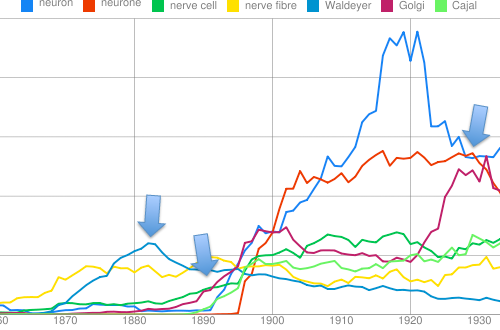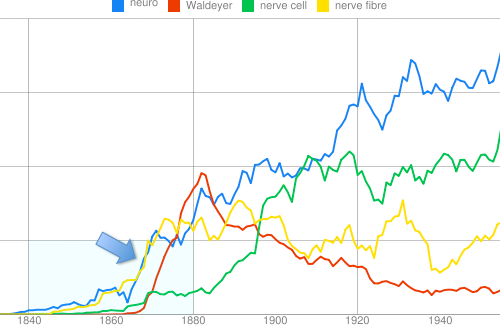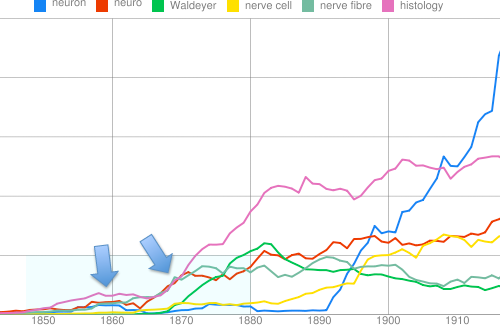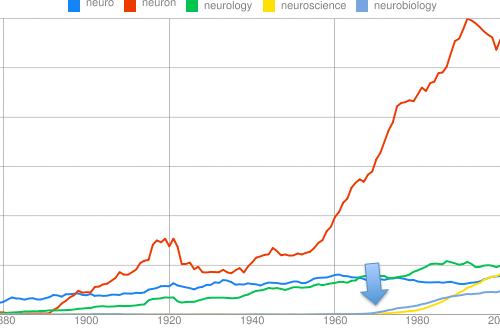To start out, let's see if we can trace the origin of the field's object of study, the neuron. I've included the two accepted spellings "neuron and "neurone" as well as "nerve cell" and "nerve fibre".*

We see that the last decades of the 19th century were absolutely decisive in the history of neuroscience. What we're really seeing is the emergence of the neuron doctrine; the idea that the nervous system is made up by discrete but interconnected cellular components, or neurons. This revolution was made possible by the works of Santiago Ramón y Cajal and Camillo Golgi (among others, but these two were the heavy hitters and received the Nobel prize in 1906), and the anatomist Heinrich Waldeyer-Hartz was the first to formally propose the doctrine in 1891. Do you see how clearly the use of "neuron" practically started around 1891? Incredible!
The fact that there are two spellings, with or without a terminal e, is a cool curiosity. We can see how the use of "neurone" sinks after the 1930's, but the two alternative variants really competed there. The use of "nerve cell" and "nerve fibre" seem to predate both of them, but their origin is definitely after 1850 and they don't rise in the same way as the 20th century comes along.
The name "Waldeyer" also has a peak before 1890. Names are always tricky, but what if we include the general prefix "neuro" in the analysis together with "Waldeyer", "nerve cell" and "nerve fibre"?

The field was clearly developing in the decades before the neuron doctrine in the 1890's, and Waldeyer seems to have been prominent in that development. We see that the use of neuro-related terms has an upward slope that follows Waldeyer's almost exactly. Waldeyer was a very prominent general anatomist and histologist of the time, so if we add the term "histology" to the analysis we can probably confirm the incredible development that lead to the emergence of modern neuroscience: the ability to chemically stain tissues and individual cells in preparation for the study under the microscope.

Much of this development seems to have had it's start in the 1850's.
Next I want to find out when the collective terms for the field like "neurology, "neuroscience" and "neurobiology" came up. Let's add those to the general "neuro"-prefix and "neuron" as references.

Although the foundations of modern neuroscience and neurobiology were laid in the late 19th century, the terms themselves don't show up until well into the 20th century! "Neurology" seems to be a much older term, perhaps indicating that the arrangement and disease states of the nervous system were under study well before the underlying mechanisms were understood. Or maybe that it used to be a more general term? It's an interesting question. According to the Oxford English Dictionary "neurology" goes back to 1681 meaning something like "systematic arrangement of nerves".
There are some more interesting experiments one could do, but this is enough for now.
*) Including "nerve" doesn't add anything useful since it's such a common word. According to the OED it goes back to the 1400's, originally meaning sinew or tendon.
Thanks! I'm doing some more ngram experiments on the history of neuroscience to be posted (hopefully) shortly.
ReplyDelete